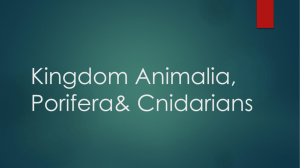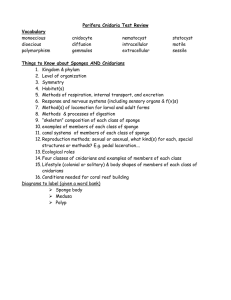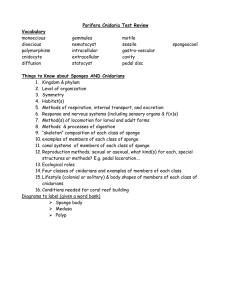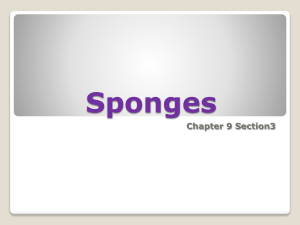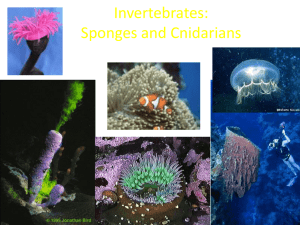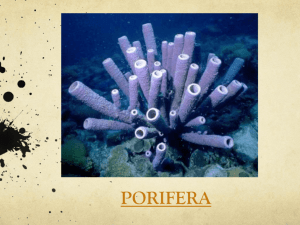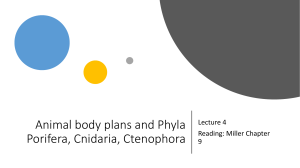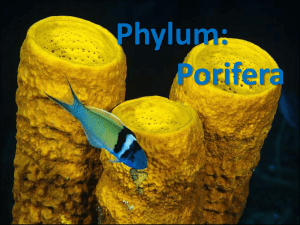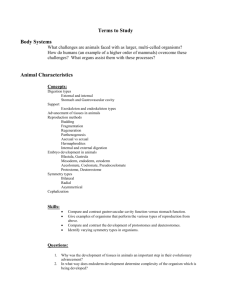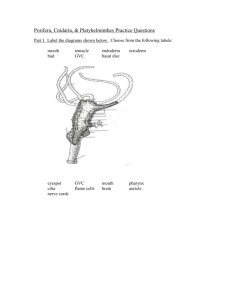Chapter 33 Notes - schallesbiology
advertisement
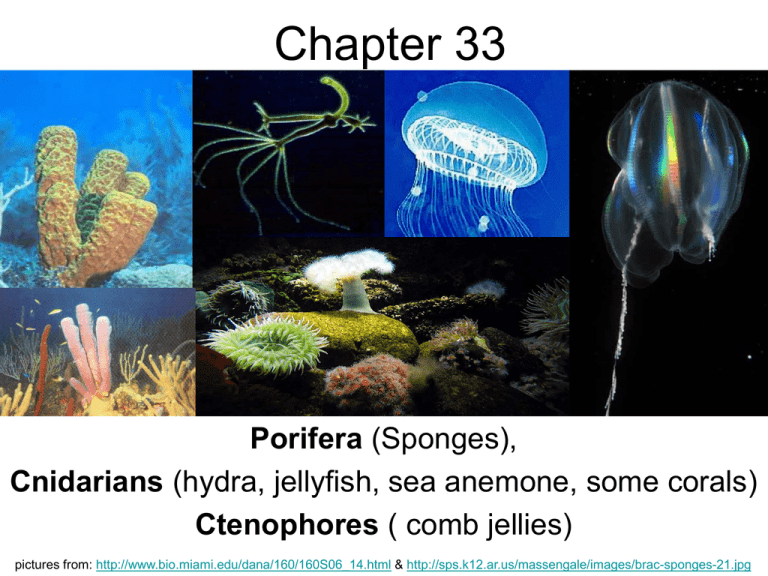
Chapter 33 Porifera (Sponges), Cnidarians (hydra, jellyfish, sea anemone, some corals) Ctenophores ( comb jellies) pictures from: http://www.bio.miami.edu/dana/160/160S06_14.html & http://sps.k12.ar.us/massengale/images/brac-sponges-21.jpg Animalia: A Progression of Complexity • As we begin discussing the animal kingdom-Consider that as animal phyla diverge, organs and organ systems are added, increasing complexity. – – – – Tissues ( # germ layers) Body symmetry Internal body cavity Organs and Organ systems: • • • • • • • • integumentary system - protection (injury, infection, water loss) digestive system - food processing nervous system - coordination; response to environment reproductive system – asexual or sexual, external or internal excretory system - removal nitrogenous waste from body fluid skeletal system - structural support circulatory system - internal distribution of materials respiratory system - gas exchange (O2 in, CO2 our) Noted from: http://www.bio.miami.edu/dana/160/160S06_14.html I. Porifera • • • • • • Invertebrate (no backbone) Asymmetrical No true tissues or organs No gastrula stage (embryonic development) Less cell specialization than other animals All species -Aquatic http://sps.k12.ar.us/massengale/images/brac-sponges-21.jpg • Adult is Sessile (attach to surface, do not move) Why are sponges considered animals? • Early biologists thought they were plants. • BUT- Have 2 key characteristics of animals: –Heterotrophic –Multicellular – (Reproduction is asexual or sexual) – (Mobility- adults are sessile- but some species can move up to 4mm/day (http://www.ucmp.berkeley.edu/porifera/poriferalh.html) *larvae have flagella.) • Represent transition from unicellular to multicellular life. A. Basic Body plan of a Sponge 1. Asymmetrical 2. Sessile 3. Vocabulary of sponge parts: • Hollow cylinder shape, closed at bottom, opening at top called Osculum. • Interior lined with Choanocytes – flagellated cells that draw water into the sponge through pores in the body wall called Ostia. • 2 layers of cells separated by mesohyl (a jelly like substance) Sponge Skeleton 2 types support- (different sponges use one or both): • Spongin - tough, flexible protein fibers or • Spicules – hard calcium carbonate (like in limestone, teeth & bones) or hard silicon dioxide (quartz, glass) Picture from: http://www-biol.paisley.ac.uk/biomedia/graphics/jpegs/SPICULES.gif http://io.uwinnipeg.ca/~simmons/Chap3298/img013.jpg B. Digestive System/Wastes 1. Filter Feeding- bits of organic matter or bacteria 2. Amoebocytes- crawling cells that deliver nutrients from choanocytes to the rest of the body 3. Digestion is Intracellular -wastes & CO2 expelled with water as it passes through osculum C. Reproductive System 1. Asexual a. Budding- part of the parent pinches off & forms a new organism b. Gemmules – a reproductive structure in sponges, -produced in harsh conditions -a food-filled ball of amoebocytes in a protective coat c. Regeneration- regrowth of missing cells. 2. Sexual a. Sperm are released into water, enters next sponge through pores, choanocytes engulf sperm. Carry to ameobocytes, carry them to egg in mesophyl. Produces a flagellated Larvae (immature form) b. Hermaphrodite- each sponge has both eggs & sperm II. Cnidaria (Hydra, Jellyfish, Sea Anemones, some corals) A. Body Plan 1. Stages: Medusa –bell shaped, swims Polyp – vase-shaped, sessile 2. 2 cell tissue layersEpidermis outside layer Gastrodermis inside layer -with Mesoglea in between) 3. Gastrovascular cavity (gut) 4. Tentacles POLYP MEDUSA http://biology.unm.edu/ccouncil/Biology_203/Images/SimpleAnimals/cnidariaDiagram.jpeg B. Digestive System/Waste 1. Cnidocytes (special defensive cell) have Nematocysts (coiled organelle with stinging filament) 2. Tentacles push prey through mouth & into gastrointestinal cavity 3. Digestion is Extracellular, wastes expelled through mouth. http://www.emc.maricopa.edu/faculty/farabee/biobk/cnidaria_1.gif C. Nervous System 1. Nerve Net -Nerve cells located below epidermis near the mesoglea interconnect and form a nerve net throughout the body. Cnidarians have both muscle fibers and nerve fibers, making these animals capable of directional movement. 2. Movement – using pulsing tentacles D. Classes 1. Hydrozoa ( 3,700 species) ex- Obelia, Portuguese Man-O War. 2. Cubozoa ex- box jellies, sea wasp 3. Scyphozoa “cup-animals” jellyfish 4. Anthozoa (6,100 species) “flower animals” like sea anemones, corals QUESTIONS: • Use your book to describe one organism from each of the 4 classes. • List & diagram the steps in describing the cnidarian hunting & feeding process (use terms for special parts.) E. Reproductive Systems• Some reproduce asexually (see Hydrabudding) especially in warmer temperatures. • Sexual reproduction– lower temps – hermaphrodites. – Motile sperm, egg in ovary. III. Ctenophora (100 species) Ctenophora means “comb holder”- named for the 8 comb-like rows of cilia that run along outside of these animals How are they different than jellyfish? A. Movement - beating cilia http://www.ucmp.berkeley.edu/cnidaria/ctenophora.html B. Digestive -ctenophores are voracious predators. -Unlike cnidarians, they lack stinging cells. (no cnidocytes) -Instead,to capture prey, have sticky cells called colloblasts. located on ends of 2 tentacles. -In a few species, special cilia in the mouth are used for biting gelatinous prey. C. Nervous- have an apical organ for sensing environment. D. Bioluminescence –glow with light they produce with chemicals
